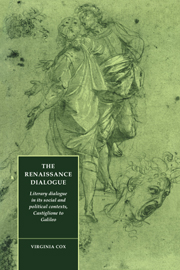 The Renaissance Dialogue
The Renaissance Dialogue Book contents
- Frontmatter
- Contents
- Preface
- 1 Problems of method
- 2 History and invention in the dialogue
- 3 The uses of the dialogue in sixteenth-century Italy: celebration and control
- 4 The uses of the dialogue in sixteenth-century Italy: commerce and courtesy
- 5 Castiglione's Cortegiano: the dialogue as a drama of doubt
- 6 The changing form of the Italian Renaissance dialogue
- 7 The theory and practice of the dialogue in Counter-Reformation Italy
- 8 From the ‘girevole strada’ to the straight and narrow path
- 9 From the open dialogue to the closed book
- Notes
- Bibliography
- Index
4 - The uses of the dialogue in sixteenth-century Italy: commerce and courtesy
Published online by Cambridge University Press: 05 December 2011
- Frontmatter
- Contents
- Preface
- 1 Problems of method
- 2 History and invention in the dialogue
- 3 The uses of the dialogue in sixteenth-century Italy: celebration and control
- 4 The uses of the dialogue in sixteenth-century Italy: commerce and courtesy
- 5 Castiglione's Cortegiano: the dialogue as a drama of doubt
- 6 The changing form of the Italian Renaissance dialogue
- 7 The theory and practice of the dialogue in Counter-Reformation Italy
- 8 From the ‘girevole strada’ to the straight and narrow path
- 9 From the open dialogue to the closed book
- Notes
- Bibliography
- Index
Summary
Oggi di … quasi tutti siamo rivolti col pensiero a contrattare
Stefano Guazzo, La civil conversazione (1574)One of the principal discrepancies between modern and pre-modern perceptions of literary discourse is that literature is no longer conceived of today, as it was within the classical, rhetorical tradition, as something ‘continuous with reality’, as ‘action in the world’. Like a classical oration, a Renaissance literary work was often addressed to a specific, closely studied audience and intended to persuade its listeners to a particular line of action. Indeed, in the Renaissance, when the writer's intentional audience was less likely to be a crowd than a small group of acquaintances and patrons, the art of ‘accommodating’ discourse to the expectations of its listeners became still more important than it had been in classical times.
The close and sociable nature of the relationship between writers and readers in the Renaissance courts affected the character of literary production in every conceivable way. In an age in which few writers were able to earn a living by their art alone, authorship constituted one element, among others, in a courtier's career. This meant that, besides its stated aims of instructing and delighting, literature was called on to perform a variety of ‘public relations’ functions for its author, ranging from flattery and self-advertisement to sniping and self-defence. Genres like the occasional poem or the commemorative dialogue represent only the tip of an iceberg of a literature gauged for its perlocutionary effects.
- Type
- Chapter
- Information
- The Renaissance DialogueLiterary Dialogue in its Social and Political Contexts, Castiglione to Galileo, pp. 34 - 46Publisher: Cambridge University PressPrint publication year: 1992
- 1
- Cited by


